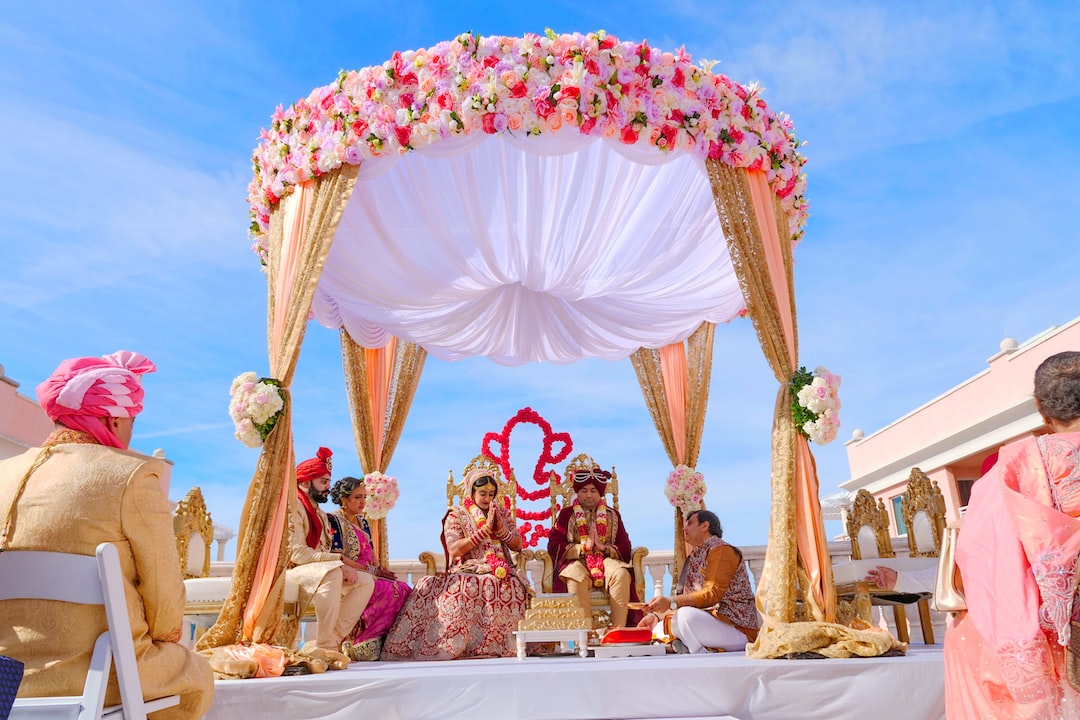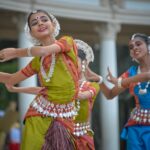Wedding planning is daunting, especially when incorporating different cultural traditions and customs.
South Indian weddings have unique rituals that will make your special day even more memorable.
From pre-wedding festivities like the mehndi ceremony to post-wedding ceremonies such as the Mangala Snaanam, South Indian wedding traditions offer an abundance of joyous celebrations for everyone involved in this beautiful event.
Let’s take a look at some of these fascinating South Indian wedding traditions so you can begin planning your perfect celebration today.
South Indian Wedding Traditions
Pre-Wedding Traditions
Pre-wedding traditions are an important part of South Indian weddings. These include the engagement ceremony, Sangeet ceremony, and Haldi ceremony.
Each of these ceremonies has its own unique customs and rituals that are followed to ensure a successful wedding.
1. Engagement Ceremony
In South Indian cultures, marriage proposals are done in a traditional and respectful manner.
Generally, the groom’s parents will approach the bride’s family and make their intentions known.
This is usually done via an informal meeting of both families, where they exchange backgrounds and histories, discuss terms of the engagement and negotiate any other particulars.
The engagement marks the formal announcement of two families coming together for marriage.
During this event, both families exchange gifts such as jewelry or clothes and perform puja (prayer) to seek blessings from God for their union.
This is usually accompanied by music, dance, and feasting with family members and close friends present at the occasion.
2. Sangeet Ceremony
The Sangeet is one of the most fun-filled pre-wedding events.
All family members come together to celebrate with singing, dancing, and music performances by relatives or professional performers hired for the occasion.
It’s also customary for bridesmaids to dress up in matching outfits while groomsmen wear ethnic attire like sherwanis or kurtas during this eventful evening.
3. Haldi Ceremony
Haldi is considered an auspicious ritual before any significant life event, including weddings in India – it symbolizes good luck & prosperity for couples who will soon be married.
During this ceremony, turmeric paste mixed with sandalwood powder is applied on both the bride & groom’s faces & bodies by their respective mothers/aunts/grandmothers as they shower them with love & blessings before taking their vows.
Wedding Day Traditions
4. Baraat Procession
The Baraat procession is an important part of South Indian weddings.
It involves the groom and his family arriving at the wedding venue in a grand manner, accompanied by music and dancing.
This ritual symbolizes the union of two families and marks the beginning of the wedding celebrations.
5. Jaimala Exchange
The Jaimala exchange is one of the most important rituals during a South Indian wedding ceremony.
In this ritual, garlands are exchanged between the bride and groom as a sign of acceptance and commitment to each other.
This custom signifies that they have accepted each other as husband and wife in front of their families, friends, and guests.
6. Mangala Snaanam
Mangala Snaanam is a traditional South Indian custom that takes place on the wedding day.
This ritual involves the groom and his family bathing in holy water, usually taken from a nearby temple or river.
The groom wears special attire known as ‘veshti’ during this ceremony.
The purpose of this ritual is to purify the mind and body before marriage. It also symbolizes the commitment between the bride and groom, welcoming them into their new lives together.
After Mangala Snaanam, an offering of fruits, flowers, and coconuts is made to God, seeking blessings for the married couple.
7. Attire
On the day of their wedding, a South Indian bride and groom traditionally wear special attire.
For the bride, this usually consists of a sari or lehenga-choli with heavy embroidery and gold jewelry. The groom typically wears a dhoti or kurta pajama with a shawl over his shoulders.
Both will have plenty of flowers adorning their hair and clothes.
Additionally, many brides and grooms also opt for traditional South Indian headdresses such as jasmine garlands for her and a turban for him.
Other clothing items such as waist belts, nose and earrings are also often worn as part of the ceremonial attire.
Post-Wedding Traditions
Post-wedding traditions are an important part of South Indian weddings.
After the wedding is over, there are several post-wedding rituals that take place in South Indian culture.
These include the reception party, Vidaai rituals, and Griha Pravesh ceremony.
8. Reception Party
The reception party marks the beginning of a new life for the newlywed couple and their families.
It is a time to celebrate with friends and family who have come from near and far to witness this special occasion.
During this event, guests will be served traditional food and drinks while music plays in the background.
At times, cultural performances such as dances or skits may also be performed by the couple’s family members or close friends to add more fun to the celebration.
9. Food and Drink
South Indian weddings are celebrated with a wide array of delicious dishes.
Traditional staples on the menu include idlis, dosas, and vadas (rice-based steamed cakes).
Other popular dishes include dosa masala or egg curry, sambar, rasam (tamarind-flavored soup), and curries made with vegetables or shrimp. Of course, no South Indian wedding would be complete without desserts like jalebi (deep fried dough soaked in syrup), payasam (sweet milk pudding) and barfi (fudge-like sweet).
All these delectable treats will guarantee that guests have a memorable experience.
10. Vidaai Rituals
Vidaai is one of the most emotional moments during any wedding ceremony, where both families bid farewell to each other after all ceremonies have been completed successfully.
This ritual symbolizes blessings from both sides for a happy married life ahead for the bride and groom.
As per tradition, gifts are exchanged between both parties before they part ways until they meet again at some point in future.
Griha Pravesh is another important post-wedding ritual which signifies welcoming a newly married couple home in their new house/home together to start their journey as husband and wife.
In this ceremony, elders bless them with rice grains on entering their new home so that it brings good luck and prosperity throughout their lives together.
Aarti (a Hindu prayer) is also performed during this ceremony along with lighting up diyas (lamps).
This marks an auspicious start towards building a strong bond between two individuals who just got united through marriage.
Other South Indian Wedding Traditions and Customs
South Indian weddings are known for their vibrant and colorful celebrations.
In addition to the pre-wedding, wedding day, and post-wedding traditions, there are several other customs that are observed during South Indian weddings.
These include mehendi ceremonies, Pithi rituals and Aashirwad blessings which all have their special significance in South Indian culture and add to the beauty of a traditional South Indian wedding celebration.
11. Mehendi Ceremony
The Mehendi ceremony is an important part of any South Indian wedding. It is usually held one or two days before the actual wedding day.
During this ceremony, female relatives or professional mehndi artists apply intricate designs made from henna paste (mehndi) on the hands and feet of both the bride and groom.
This tradition symbolizes joyousness as well as good luck for the couple’s future together.
12. Pithi Rituals
Pithis are sacred turmeric pastes that consist of herbs, flowers, sandalwood powder etc., which are applied on both bride’s body as well as the groom’s body before marriage rituals like Saat Pheras (seven rounds around holy fire).
This ritual is believed to bring good fortune for newly married couples while also cleansing them spiritually before they start their new life together.
Aashirwad blessing is another vital custom in most South Indian weddings where elders bless the couple with rice grains mixed with turmeric powder after they exchange garlands during Jaimala ceremony at mandapam (marriage hall).
This blessing signifies prosperity for newly married couples who will embark upon a journey full of love and happiness.
13. South Indian Wedding Superstitions
South India is a region where superstitions are still highly believed in.
Some common superstitions related to weddings include the belief that an even number of guests should be invited a bride must never look at herself in the mirror after her head has been adorned with jewelry.
It is lucky to hear the cawing of crows during the wedding procession.
On the other hand, some believe it is bad luck for a married couple to marry on Saturday, and there should be no stepping on the bride’s feet while carrying her during the traditional ceremony.
Moreover, many families avoid discussing death or anything negative on the wedding day.
Conclusion
From pre-wedding to post-wedding rituals, each tradition is an important part of the culture, making up a beautiful union between two families.
Whether you’re looking for traditional ceremonies or modern customs, these South Indian wedding traditions will ensure your special day is one to remember.




